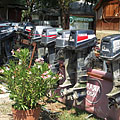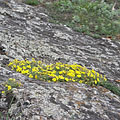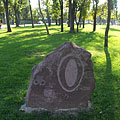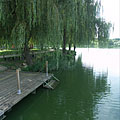(Optimeeritud väike ekraan seadmete)
Downtown, other locations - Vác, Ungari
Kui klõpsate:
Klõpsa pildid!
-
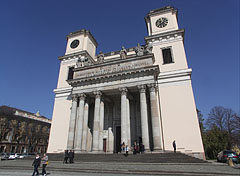
Pildistamise kuupäev: 9.3.20142014
Loodud: Robert Németh
Kaamera mudel: Konica Minolta Dimage A200
Vác, Ungari
-
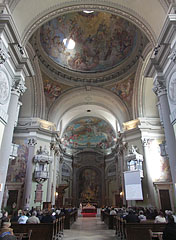
Pildistamise kuupäev: 9.3.20142014
Loodud: Robert Németh
Kaamera mudel: Konica Minolta Dimage A200
Vác, Ungari
-
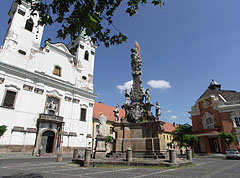
Piarist Church of Saint Ann and the Holy Trinity column
Pildistamise kuupäev: 24.5.20082008
Loodud: Robert Németh
Kaamera mudel: Konica Minolta Dimage A200
Vác, Ungari
-
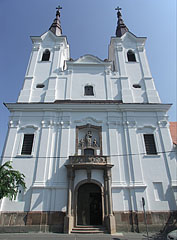
Vác, Ungari
-

Pildistamise kuupäev: 9.3.20142014
Loodud: Robert Németh
Kaamera mudel: Konica Minolta Dimage A200
Vác, Ungari
-
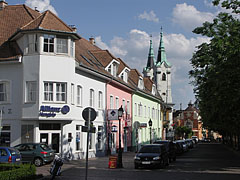
Colorful row of houses and steeples of the Saint Ann's Piarist Church
Pildistamise kuupäev: 24.5.20082008
Loodud: Robert Németh
Kaamera mudel: Konica Minolta Dimage A200
Vác, Ungari
-
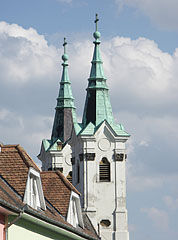
View of the double spires of the St. Anne's Piarist Church
Pildistamise kuupäev: 24.5.20082008
Loodud: Robert Németh
Kaamera mudel: Konica Minolta Dimage A200
Vác, Ungari
-
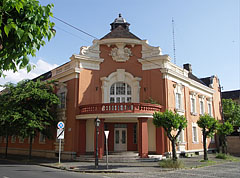
An ornate house on the Szentháromság Square (Holy Trinity Square)
Pildistamise kuupäev: 24.5.20082008
Loodud: Robert Németh
Kaamera mudel: Konica Minolta Dimage A200
Vác, Ungari
-
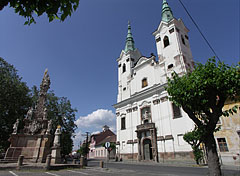
St. Ann's Piarist Church and Monastery of Vác
Pildistamise kuupäev: 24.5.20082008
Loodud: Robert Németh
Kaamera mudel: Konica Minolta Dimage A200
Vác, Ungari
-
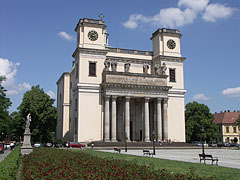
Episcopal Cathedral of Vác (sometimes also called Vác Dome or Great Church of Vác)
Pildistamise kuupäev: 24.5.20082008
Loodud: Robert Németh
Kaamera mudel: Konica Minolta Dimage A200
Vác, Ungari
-
Episcopal Cathedral of Vác (in Hungarian: Váci székesegyház)
Pildistamise kuupäev: 24.5.20082008
Loodud: Robert Németh
Kaamera mudel: Konica Minolta Dimage A200
Vác, Ungari
Episcopal Cathedral of Vác (in Hungarian: Váci székesegyház) - Vác, Ungari -
Episcopal Cathedral of Vác
Pildistamise kuupäev: 24.5.20082008
Loodud: Robert Németh
Kaamera mudel: Konica Minolta Dimage A200
Vác, Ungari
Episcopal Cathedral of Vác - Vác, Ungari -
Guests are coming to the wedding at the Nagyboldogasszony püspöki székesegyház (Váci székesegyház) épületénél
Pildistamise kuupäev: 24.5.20082008
Loodud: Robert Németh
Kaamera mudel: Konica Minolta Dimage A200
Vác, Ungari
Guests are coming to the wedding at the Nagyboldogasszony püspöki székesegyház (Váci székesegyház) épületénél - Vác, Ungari -
Holy Trinity column in front of the St. Ann's Piarst Church
Pildistamise kuupäev: 24.5.20082008
Loodud: Robert Németh
Kaamera mudel: Konica Minolta Dimage A200
Vác, Ungari
Holy Trinity column in front of the St. Ann's Piarst Church - Vác, Ungari -
Pildistamise kuupäev: 24.5.20082008
Loodud: Robert Németh
Kaamera mudel: Konica Minolta Dimage A200
Vác, Ungari
- Vác, Ungari -
Pildistamise kuupäev: 24.5.20082008
Loodud: Robert Németh
Kaamera mudel: Konica Minolta Dimage A200
Vác, Ungari
- Vác, Ungari -
The interesting entrance of the Váczi Sörház ("Beer House of Vác"); the street on the left after some stairs goes down to the Danube promenade
Pildistamise kuupäev: 13.7.20092009
Loodud: Robert Németh
Kaamera mudel: Konica Minolta Dimage A200
Vác, Ungari
The interesting entrance of the Váczi Sörház ("Beer House of Vác"); the street on the left after some stairs goes down to the Danube promenade - Vác, Ungari -
Holy Trinity column in front of the Piarst Church of St. Anne
Pildistamise kuupäev: 13.7.20092009
Loodud: Robert Németh
Kaamera mudel: Konica Minolta Dimage A200
Vác, Ungari
Holy Trinity column in front of the Piarst Church of St. Anne - Vác, Ungari -
Old door on the 18th century piarist friary
Pildistamise kuupäev: 13.7.20092009
Loodud: Robert Németh
Kaamera mudel: Konica Minolta Dimage A200
Vác, Ungari
Old door on the 18th century piarist friary - Vác, Ungari -
Old marble inscription on the wall of the Piarist Friary of Vác
Pildistamise kuupäev: 13.7.20092009
Loodud: Robert Németh
Kaamera mudel: Konica Minolta Dimage A200
Vác, Ungari
Old marble inscription on the wall of the Piarist Friary of Vác - Vác, Ungari -
Piarist Church of Saint Anne with the building of the friary
Pildistamise kuupäev: 13.7.20092009
Loodud: Robert Németh
Kaamera mudel: Konica Minolta Dimage A200
Vác, Ungari
Piarist Church of Saint Anne with the building of the friary - Vác, Ungari -
Pildistamise kuupäev: 13.7.20092009
Loodud: Robert Németh
Kaamera mudel: Konica Minolta Dimage A200
Vác, Ungari
- Vác, Ungari -
Statue of St. Stephen I King of Hungary at the Episcopal Palace, on its pedestal the relief represents the foundation of the Vác Bishopric
It was inaugurated in 1938, for the 900th anniversary of the death of the king.
Pildistamise kuupäev: 13.7.20092009
Loodud: Robert Németh
Kaamera mudel: Konica Minolta Dimage A200
Vác, Ungari
Statue of St. Stephen I King of Hungary at the Episcopal Palace, on its pedestal the relief represents the foundation of the Vác Bishopric - Vác, Ungari -
Pildistamise kuupäev: 13.7.20092009
Loodud: Robert Németh
Kaamera mudel: Konica Minolta Dimage A200
Vác, Ungari
- Vác, Ungari -
The so-called Greek Church of Vác
Pildistamise kuupäev: 13.7.20092009
Loodud: Robert Németh
Kaamera mudel: Konica Minolta Dimage A200
Vác, Ungari
The so-called Greek Church of Vác - Vác, Ungari -
Pildistamise kuupäev: 13.7.20092009
Loodud: Robert Németh
Kaamera mudel: Konica Minolta Dimage A200
Vác, Ungari
- Vác, Ungari -
The huge door of the Episcopal Cathedral of Vác
Pildistamise kuupäev: 19.5.20072007
Loodud: Robert Németh
Kaamera mudel: Konica Minolta Dimage A200
Vác, Ungari
The huge door of the Episcopal Cathedral of Vác - Vác, Ungari -
Pildistamise kuupäev: 19.5.20072007
Loodud: Robert Németh
Kaamera mudel: Konica Minolta Dimage A200
Vác, Ungari
- Vác, Ungari -
Pildistamise kuupäev: 19.5.20072007
Loodud: Robert Németh
Kaamera mudel: Konica Minolta Dimage A200
Vác, Ungari
- Vác, Ungari -
Pildistamise kuupäev: 19.5.20072007
Loodud: Robert Németh
Kaamera mudel: Konica Minolta Dimage A200
Vác, Ungari
- Vác, Ungari -
Pildistamise kuupäev: 19.5.20072007
Loodud: Robert Németh
Kaamera mudel: Konica Minolta Dimage A200
Vác, Ungari
- Vác, Ungari -
Episcopal Cathedral of Vác (Váci székesegyház)
Pildistamise kuupäev: 13.7.20062006
Loodud: Robert Németh
Kaamera mudel: Konica Minolta Dimage A200
Vác, Ungari
Episcopal Cathedral of Vác (Váci székesegyház) - Vác, Ungari -
Episcopal Cathedral of Vác (Váci székesegyház)
Pildistamise kuupäev: 13.7.20062006
Loodud: Robert Németh
Kaamera mudel: Konica Minolta Dimage A200
Vác, Ungari
Episcopal Cathedral of Vác (Váci székesegyház) - Vác, Ungari -
Pildistamise kuupäev: 9.3.20142014
Loodud: Robert Németh
Kaamera mudel: Konica Minolta Dimage A200
Vác, Ungari
- Vác, Ungari -
Pildistamise kuupäev: 9.3.20142014
Loodud: Robert Németh
Kaamera mudel: Konica Minolta Dimage A200
Vác, Ungari
- Vác, Ungari -
Pildistamise kuupäev: 9.3.20142014
Loodud: Robert Németh
Kaamera mudel: Konica Minolta Dimage A200
Vác, Ungari
- Vác, Ungari -
Pildistamise kuupäev: 9.3.20142014
Loodud: Robert Németh
Kaamera mudel: Konica Minolta Dimage A200
Vác, Ungari
- Vác, Ungari -
Pildistamise kuupäev: 9.3.20142014
Loodud: Robert Németh
Kaamera mudel: Konica Minolta Dimage A200
Vác, Ungari
- Vác, Ungari -
Pildistamise kuupäev: 9.3.20142014
Loodud: Robert Németh
Kaamera mudel: Konica Minolta Dimage A200
Vác, Ungari
- Vác, Ungari -
Pildistamise kuupäev: 9.3.20142014
Loodud: Robert Németh
Kaamera mudel: Konica Minolta Dimage A200
Vác, Ungari
- Vác, Ungari -
Pildistamise kuupäev: 9.3.20142014
Loodud: Robert Németh
Kaamera mudel: Konica Minolta Dimage A200
Vác, Ungari
- Vác, Ungari -
Pildistamise kuupäev: 9.3.20142014
Loodud: Robert Németh
Kaamera mudel: Konica Minolta Dimage A200
Vác, Ungari
- Vác, Ungari -
Pildistamise kuupäev: 9.3.20142014
Loodud: Robert Németh
Kaamera mudel: Konica Minolta Dimage A200
Vác, Ungari
- Vác, Ungari -
Pildistamise kuupäev: 9.3.20142014
Loodud: Robert Németh
Kaamera mudel: Konica Minolta Dimage A200
Vác, Ungari
- Vác, Ungari -
Pildistamise kuupäev: 9.3.20142014
Loodud: Robert Németh
Kaamera mudel: Konica Minolta Dimage A200
Vác, Ungari
- Vác, Ungari -
Pildistamise kuupäev: 9.3.20142014
Loodud: Robert Németh
Kaamera mudel: Konica Minolta Dimage A200
Vác, Ungari
- Vác, Ungari -
Pildistamise kuupäev: 9.3.20142014
Loodud: Robert Németh
Kaamera mudel: Konica Minolta Dimage A200
Vác, Ungari
- Vác, Ungari -
Pildistamise kuupäev: 9.3.20142014
Loodud: Robert Németh
Kaamera mudel: Konica Minolta Dimage A200
Vác, Ungari
- Vác, Ungari -
Pildistamise kuupäev: 9.3.20142014
Loodud: Robert Németh
Kaamera mudel: Konica Minolta Dimage A200
Vác, Ungari
- Vác, Ungari -
Pildistamise kuupäev: 9.3.20142014
Loodud: Robert Németh
Kaamera mudel: Konica Minolta Dimage A200
Vác, Ungari
- Vác, Ungari -
Pildistamise kuupäev: 9.3.20142014
Loodud: Robert Németh
Kaamera mudel: Konica Minolta Dimage A200
Vác, Ungari
- Vác, Ungari -
Pildistamise kuupäev: 9.3.20142014
Loodud: Robert Németh
Kaamera mudel: Konica Minolta Dimage A200
Vác, Ungari
- Vác, Ungari -
Pildistamise kuupäev: 9.3.20142014
Loodud: Robert Németh
Kaamera mudel: Konica Minolta Dimage A200
Vác, Ungari
- Vác, Ungari -
Pildistamise kuupäev: 9.3.20142014
Loodud: Robert Németh
Kaamera mudel: Konica Minolta Dimage A200
Vác, Ungari
- Vác, Ungari -
Pildistamise kuupäev: 9.3.20142014
Loodud: Robert Németh
Kaamera mudel: Konica Minolta Dimage A200
Vác, Ungari
- Vác, Ungari -
Pildistamise kuupäev: 9.3.20142014
Loodud: Robert Németh
Kaamera mudel: Konica Minolta Dimage A200
Vác, Ungari
- Vác, Ungari -
Pildistamise kuupäev: 9.3.20142014
Loodud: Robert Németh
Kaamera mudel: Konica Minolta Dimage A200
Vác, Ungari
- Vác, Ungari -
Pildistamise kuupäev: 9.3.20142014
Loodud: Robert Németh
Kaamera mudel: Konica Minolta Dimage A200
Vác, Ungari
- Vác, Ungari -
Pildistamise kuupäev: 9.3.20142014
Loodud: Robert Németh
Kaamera mudel: Konica Minolta Dimage A200
Vác, Ungari
- Vác, Ungari -
Pildistamise kuupäev: 9.3.20142014
Loodud: Robert Németh
Kaamera mudel: Konica Minolta Dimage A200
Vác, Ungari
- Vác, Ungari -
Pildistamise kuupäev: 9.3.20142014
Loodud: Robert Németh
Kaamera mudel: Konica Minolta Dimage A200
Vác, Ungari
- Vác, Ungari -
Pildistamise kuupäev: 9.3.20142014
Loodud: Robert Németh
Kaamera mudel: Konica Minolta Dimage A200
Vác, Ungari
- Vác, Ungari -
Pildistamise kuupäev: 9.3.20142014
Loodud: Robert Németh
Kaamera mudel: Konica Minolta Dimage A200
Vác, Ungari
- Vác, Ungari -
Pildistamise kuupäev: 9.3.20142014
Loodud: Robert Németh
Kaamera mudel: Konica Minolta Dimage A200
Vác, Ungari
- Vác, Ungari -
Pildistamise kuupäev: 9.3.20142014
Loodud: Robert Németh
Kaamera mudel: Konica Minolta Dimage A200
Vác, Ungari
- Vác, Ungari -
Pildistamise kuupäev: 9.3.20142014
Loodud: Robert Németh
Kaamera mudel: Konica Minolta Dimage A200
Vác, Ungari
- Vác, Ungari -
Pildistamise kuupäev: 9.3.20142014
Loodud: Robert Németh
Kaamera mudel: Konica Minolta Dimage A200
Vác, Ungari
- Vác, Ungari -
Pildistamise kuupäev: 9.3.20142014
Loodud: Robert Németh
Kaamera mudel: Konica Minolta Dimage A200
Vác, Ungari
- Vác, Ungari -
Pildistamise kuupäev: 9.3.20142014
Loodud: Robert Németh
Kaamera mudel: Konica Minolta Dimage A200
Vác, Ungari
- Vác, Ungari -
Pildistamise kuupäev: 9.3.20142014
Loodud: Robert Németh
Kaamera mudel: Konica Minolta Dimage A200
Vác, Ungari
- Vác, Ungari -
Pildistamise kuupäev: 9.3.20142014
Loodud: Robert Németh
Kaamera mudel: Konica Minolta Dimage A200
Vác, Ungari
- Vác, Ungari -
Pildistamise kuupäev: 9.3.20142014
Loodud: Robert Németh
Kaamera mudel: Konica Minolta Dimage A200
Vác, Ungari
- Vác, Ungari -
Pildistamise kuupäev: 9.3.20142014
Loodud: Robert Németh
Kaamera mudel: Konica Minolta Dimage A200
Vác, Ungari
- Vác, Ungari -
Pildistamise kuupäev: 9.3.20142014
Loodud: Robert Németh
Kaamera mudel: Konica Minolta Dimage A200
Vác, Ungari
- Vác, Ungari -
Pildistamise kuupäev: 9.3.20142014
Loodud: Robert Németh
Kaamera mudel: Konica Minolta Dimage A200
Vác, Ungari
- Vác, Ungari
Klõpsa pildid!
Omadused, tunnused
Asukoht:
GPS koordinaadid: Laiuskraad 47°46'31", Pikkuskraad 19°7'49" (N47 46.52 - E19 7.82)
Andmeid, lühijutte, huvitavaid fakte
 View of the double spires of the St. Anne's Piarist Church
View of the double spires of the St. Anne's Piarist Church
The Roman Catholic Piarist religious order was founded in 1597 by Saint Joseph Calasanctius, who has a statue for example on the facade of the Piarist Church of Vác, above the balcony. Soon after in 1642 their expansion reached the border of Poland and Hungary. Firstly they reached Podolin, Privigye (Prievidza) and Nyitra (Nitra) towns, which are in the present-day Slovakia, then in 1714 they already arrived in the southern border of the "Felvidék" ("Upper Hungary"), the Danube Bend and the surroundings of Vác. The bishop of Vác welcomed them so much because he believed they will help him to achieve his big aim, to suppress the Calvinists in Vác. So from then the Piarists ran the parish until 1717, when Count Michael Althann was consecrated as the new bishop.
 St. Ann's Piarist Church and Monastery of Vác
St. Ann's Piarist Church and Monastery of Vác
The initially pure baroque style Piarist Church of Vác was built between 1725-1745, but the original onion-domed towers were rebuilt in 1886 due to their very bad condition. On the facade of the church over the balcony there is a statue of Saint Joseph Calasanctius, the founder of the Piarist Order. Among the fixtures it should be mentioned the unique altar with a Venetian mirror. The ornate church tabernacle (small cupboard, chest or cabinet) on the main altar was made in 1759. The church is situated on the "Szentháromság tér" ("Holy Trinity Square") which was a fish marked in the past.
 Episcopal Cathedral of Vác (sometimes also called Vác Dome or Great Church of Vác)
Episcopal Cathedral of Vác (sometimes also called Vác Dome or Great Church of Vác)
The building of the Cathedral of Vác (in Hungarian "Váci Székesegyház") was the decision of Károly Eszterházy, who was the bishop of Vác and later also bishop of Eger town, where today a square and a university college preserve his name. He had the fence which separated the Hungarian and German inhabitants broken down and had the Konstantin Square made which became the site of the planned cathedral.
The cathedral has impressive dimensions: 72 meters long, 34 meters in width and the dome is 55 meters tall. Its tower clock was made by the Rancz Első Magyar Toronyóragyár (literally "Rancz's First Hungarian Tower Clock Factory"). The church was consecrated in 1772 and the furnishment was completed five years later.
 Holy Trinity column in front of the Piarst Church of St. Anne
Holy Trinity column in front of the Piarst Church of St. Anne
The baroque style sandstone Holy Trinity Column was created in 1755 and it commemorates the plague epidemic of 1740-1741. The sculpture represents primarily the patron saint of plagues, and also the ecclesiastical coat of arms of Vác town, which was at that time divided into Püspök-Vác and Káptalan-Vác ("Bishop-Vác" and "Chapter-Vác" dioceses) by the church. Behind the sculpture group on the square the entrance of the Thermal Bath and Swimming Pool of Vác can be found.
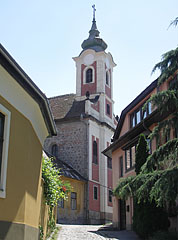 The so-called Greek Church of Vác
The so-called Greek Church of Vác
The late baroque style Orthodox so-called Greek Chruch ("Görög-templom") was built in 1790 by Southern Slavic merchant families who settled down in Vác. In 1963 it was converted to a museum, since 1973 it houses the Tragor Ignác Museum and other temporary exhibitions.
Right next to the exhibition hall of the Greek Church there is a 700 years old stone cellar in the house at 19 Március 15 tér (square). This is the place of a permanent exhibition called "Memento Mori", which presents the 18th-century cemetery crypt that was found in the Church of the Whites ("Fehérek temploma"). By the exhibited artifact not just the burial culture of that time can be explored, but also the daily life of those people.
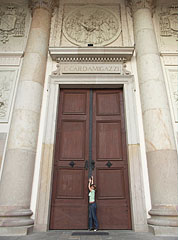 The huge door of the Episcopal Cathedral of Vác
The huge door of the Episcopal Cathedral of Vác
The construction was begun by the plans of the Austrian architect Franz Anton Pilgram, the foundation was laid in 1761. After Kristóf Migazzi became the bishop of Vác he looked for a more cost-effective solution and called the French-born Austrian architect Isidore Canevale to design a less expensive cathedral on the already completed foundations. The head of the construction was the same person who designed the Great Church of Kecskemét, the Piarist friar Gáspár Oswald.
 Episcopal Cathedral of Vác (Váci székesegyház)
Episcopal Cathedral of Vác (Váci székesegyház)
Since the establisment of the Bishopric of Vác (in Hungarian "Váci Püspökség") the current one is already the third episcopal cathedral in the town, and also on the third location. The first cathedral was erected in the age of King Géza I of Hungary from the Árpád dynasty (the second half of the 11th century), that church was situated in the former Castle of Vác, on the site of the present-day Franciscan church on the Géza király tér (square). It was destroyed during the Mongol Invasion of Hungary (in Hungarian "Tatárjárás", 1241-1242), the Mongols set it on fire.
The second one was the St. Michael's Parish Church ("Szent Mihály-plébániatemplom") which was built around the early-14th century by South German settlers who arrived here at the invitation of King Béla IV of Hungary. It was built on the place of a 11th-12th-century smaller church on the location where today the town square of Vác ("Március 15. tér") is situated. Sometimes in the early-15th centuryThe building was rebuilt and extended in gothic style. This church was ruined during the Turkish wars and occupation era (in Vác it was between 1544-1686), but the Christians allowed to use it all the while. After the Turks were driven out of the town (1686) the Catholics took the ruined building from the Protestants who used it untin then. The Catholics wanted to make it as an episcopal seat, but despite the more expansions of the building it still wasn't suitable to be a cathedral. Perhaps also due to this in 1760 the construction works that were started in 1755 were stopped by Bishop Károly Eszterházy, and he decided to built a completely new main church on a third site.
This became the current Vác Cathedral or Cathedral of the Assumption and St Michael ("Nagyboldogasszony püspöki székesegyház") on the present-day Konstantin tér (square). The church was completed in 1772, and the interior is in 1777. Under the entire church there is an undercroft (crypt) with the burial places of bishops, canons and secularist peoples, separated from each other.
Vác - Rohkem pildigaleriid:
Samuti võite olla huvitatud (Seotud lehed):
Reisijuhi sihtkohad:
Vác (232 fotot + 2 panoraampilte)
Danube Bend (Dunakanyar) (1 769 fotot + 6 panoraampilte)
Pest megye (county) (15 122 fotot + 50 panoraampilte)
Budapest ja selle ümbrus (15 989 fotot + 52 panoraampilte)
Ungari (27 287 fotot + 163 panoraampilte)
ja lisaks:
(jooksul siin: Pest megye ja Danube Bend)
Pilis Mountains (Pilis hegység) (335 fotot)
Buda Hills (Budai-hegység) (8 632 fotot + 21 panoraampilte)
Gödöllő Hills (Gödöllői-dombság) (4 203 fotot + 21 panoraampilte)
Visegrád Mountains (Visegrádi-hegység) (116 fotot + 1 panoraampilte)
Cegléd (125 fotot + 2 panoraampilte)
Ráckeve (92 fotot)
Dunakeszi (259 fotot)
Göd (23 fotot)
Nagykőrös (250 fotot + 2 panoraampilte)
Nagymaros (31 fotot)
Pilisvörösvár (88 fotot)
Szentendre (597 fotot + 1 panoraampilte)
Visegrád (220 fotot + 1 panoraampilte)
Esztergom (110 fotot + 1 panoraampilte)
Dunakeszi (259 fotot)
Göd (23 fotot)
Nagymaros (31 fotot)
Szentendre (597 fotot + 1 panoraampilte)
Visegrád (220 fotot + 1 panoraampilte)
Csővár (105 fotot)
Kóspallag (53 fotot)
Márianosztra (37 fotot)
Nagybörzsöny (4 fotot)
Pilisszentkereszt (122 fotot)
Nógrád (181 fotot)
Zsámbék
Iga panoraamfoto siin:
Vác (2 fotot)
Danube Bend (Dunakanyar) (6 fotot)
Pest megye (county) (50 fotot)
Budapest ja selle ümbrus (52 fotot)
Ungari (163 fotot)
Euroopa (165 fotot)
Iga tavaline foto siin:
Vác (232 fotot / 4 galeriid)
Danube Bend (Dunakanyar) (1 769 fotot / 31 galeriid)
Pest megye (county) (15 122 fotot / 221 galeriid)
Budapest ja selle ümbrus (15 989 fotot / 234 galeriid)
Ungari (27 287 fotot / 462 galeriid)
Euroopa (30 494 fotot / 523 galeriid)
https://www.panadea.com/et/guidebook/vac/photos/gal-002

Lisa Lemmikutesse Lisa Järjehoidjatesse
Jagage oma sõpradega!
jne
Firmast - Õigusteave -
Kõik õigused kaitstud
- ©2010-2022
Neuronit Creative Studio - Mogyoród / Budapest / Ungari


